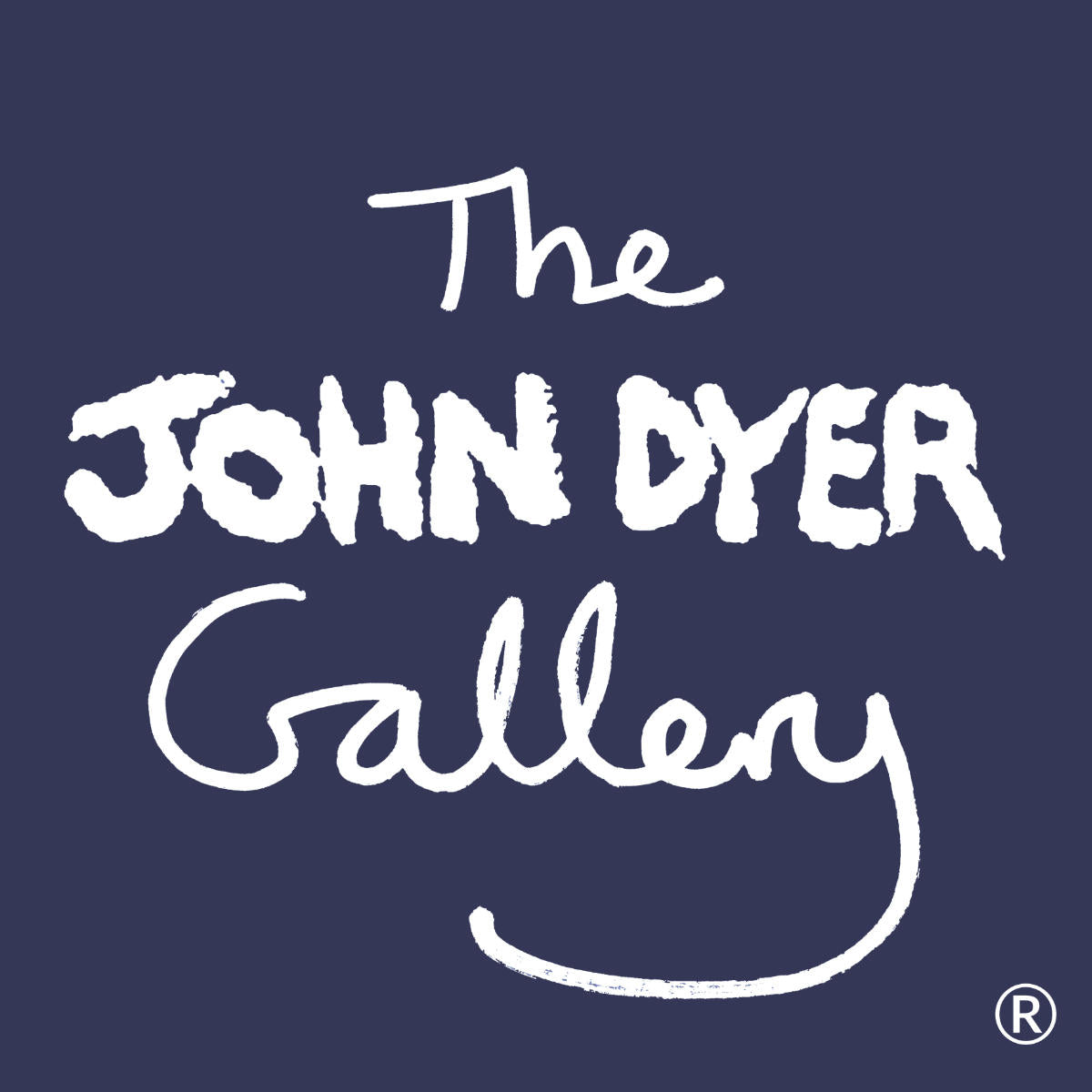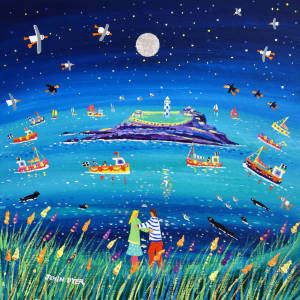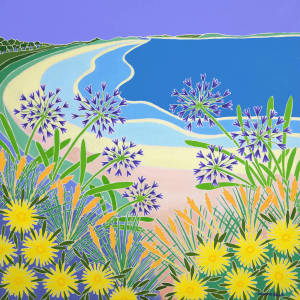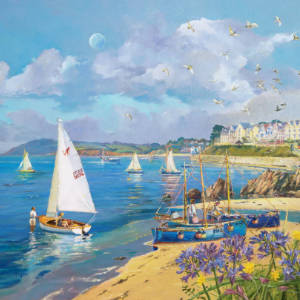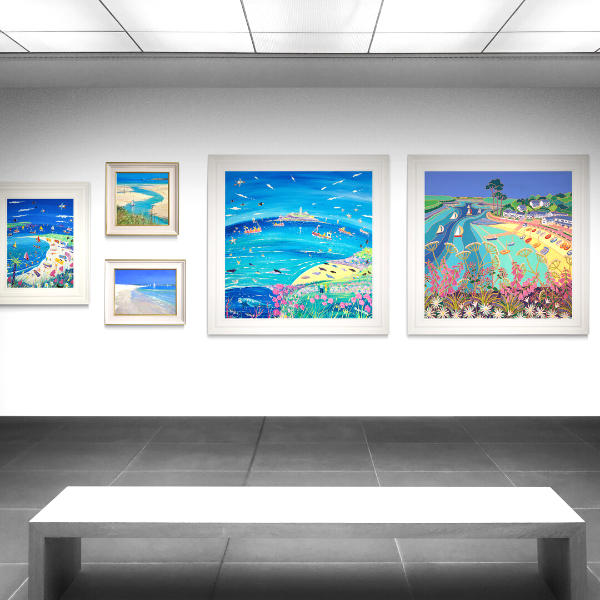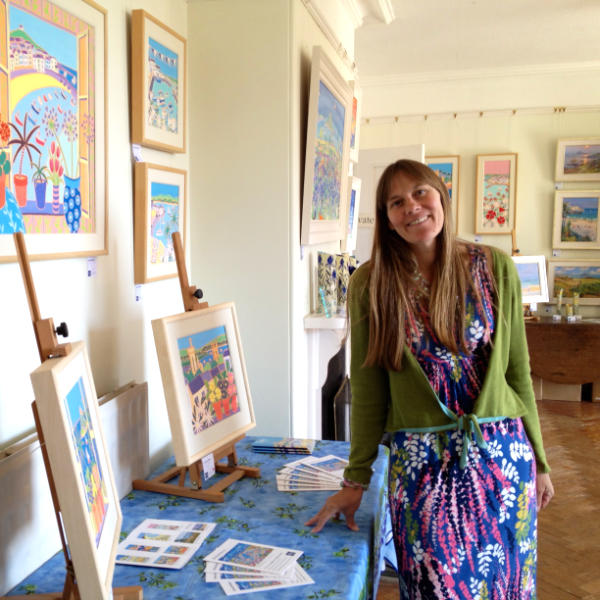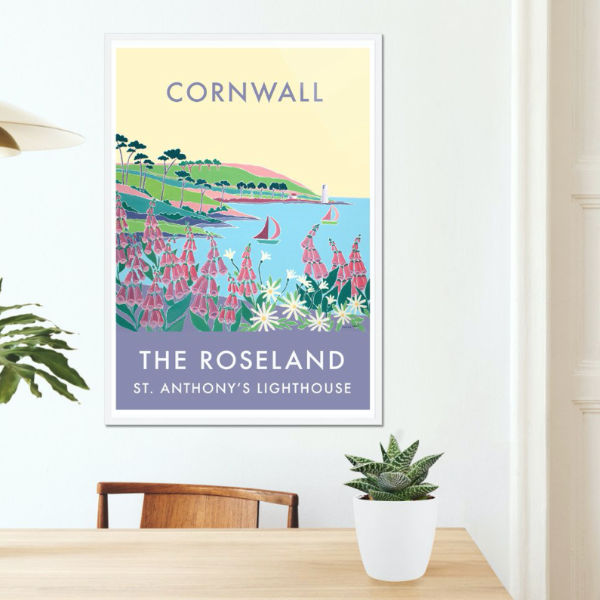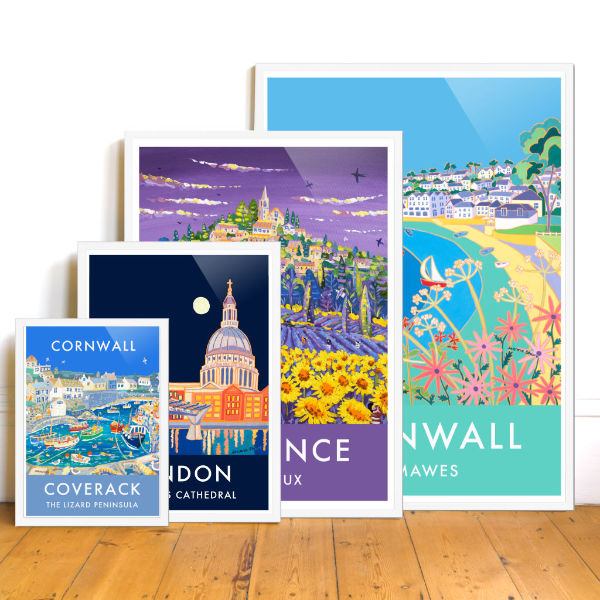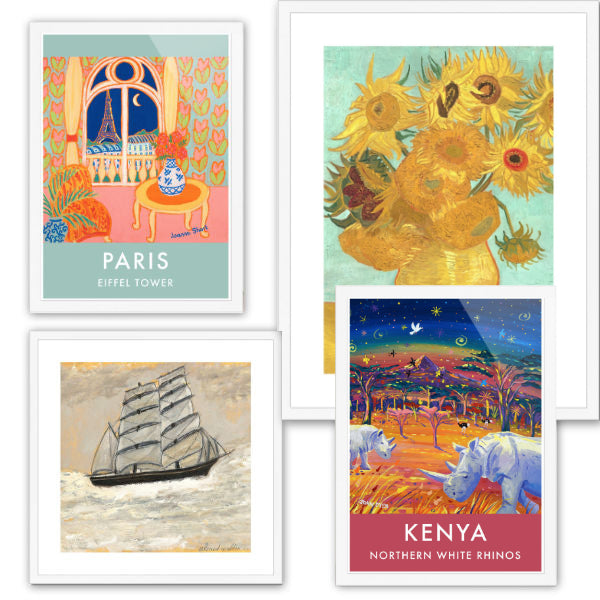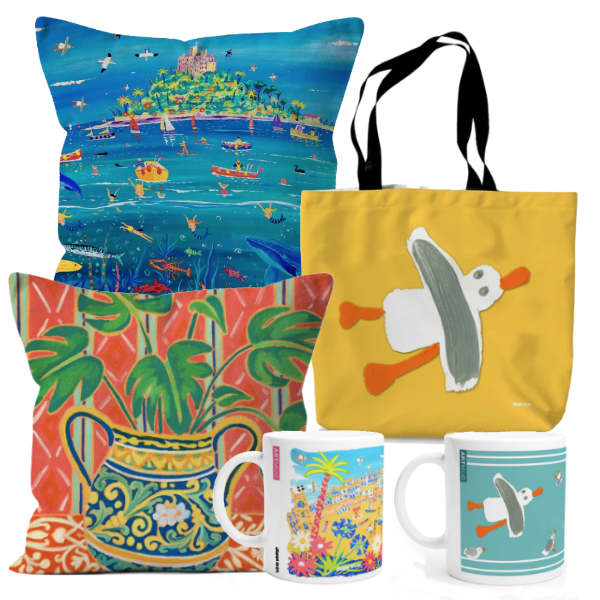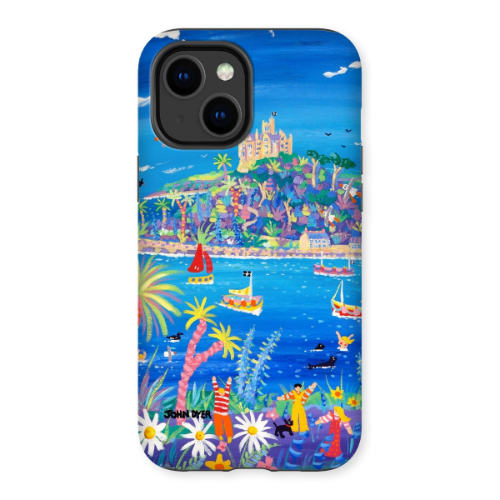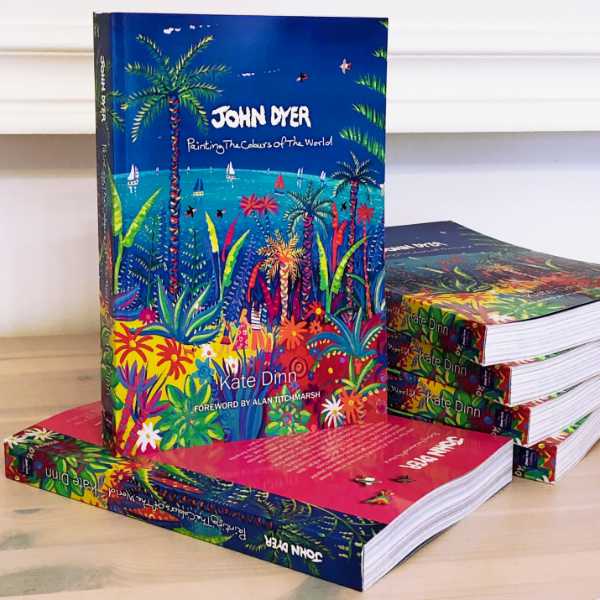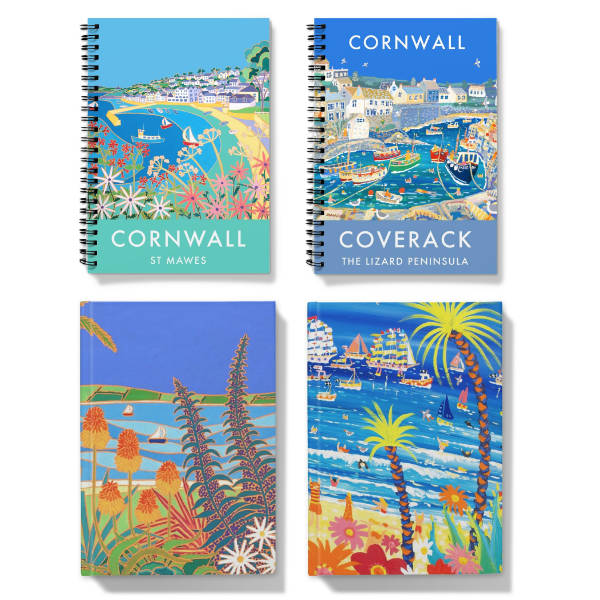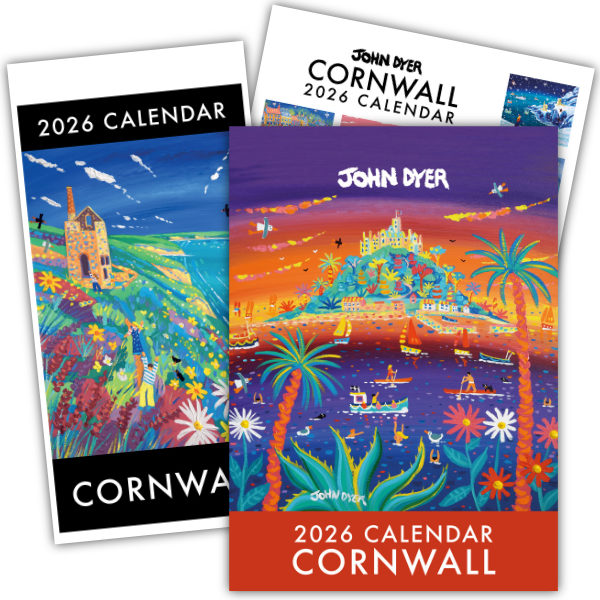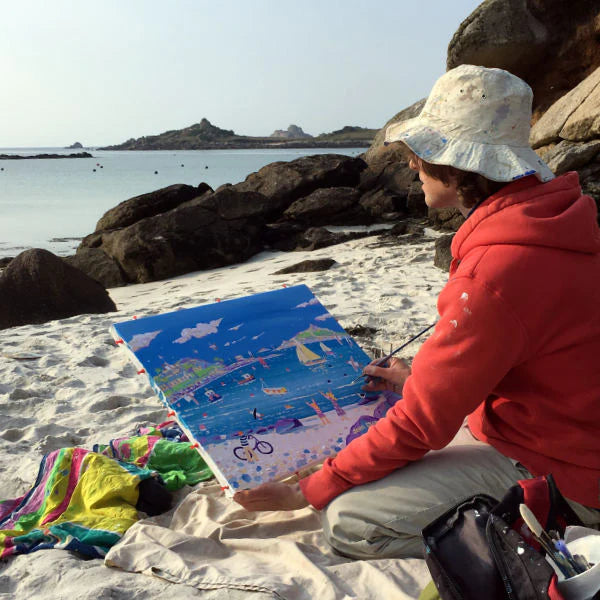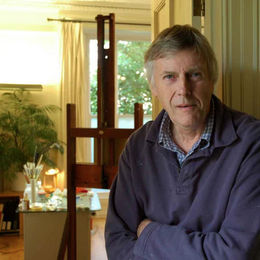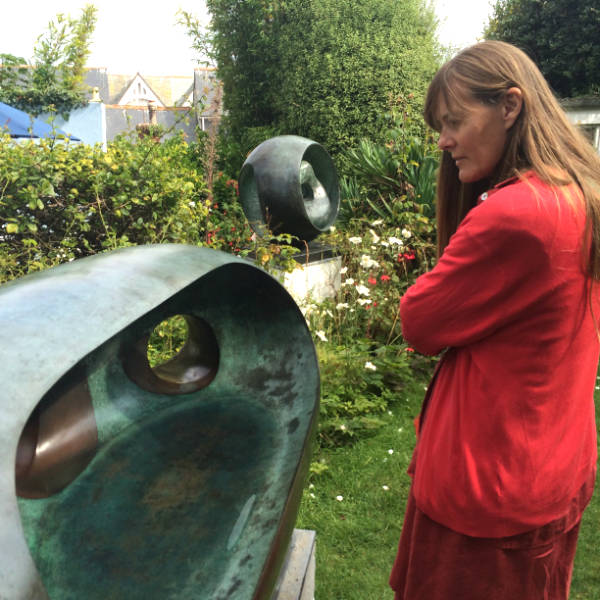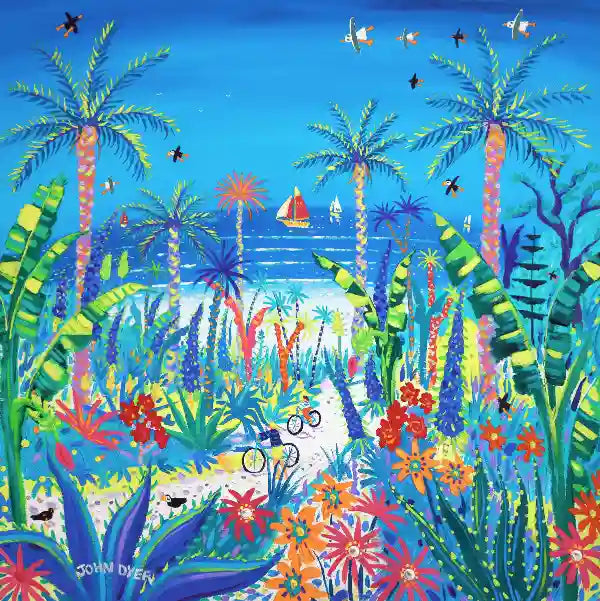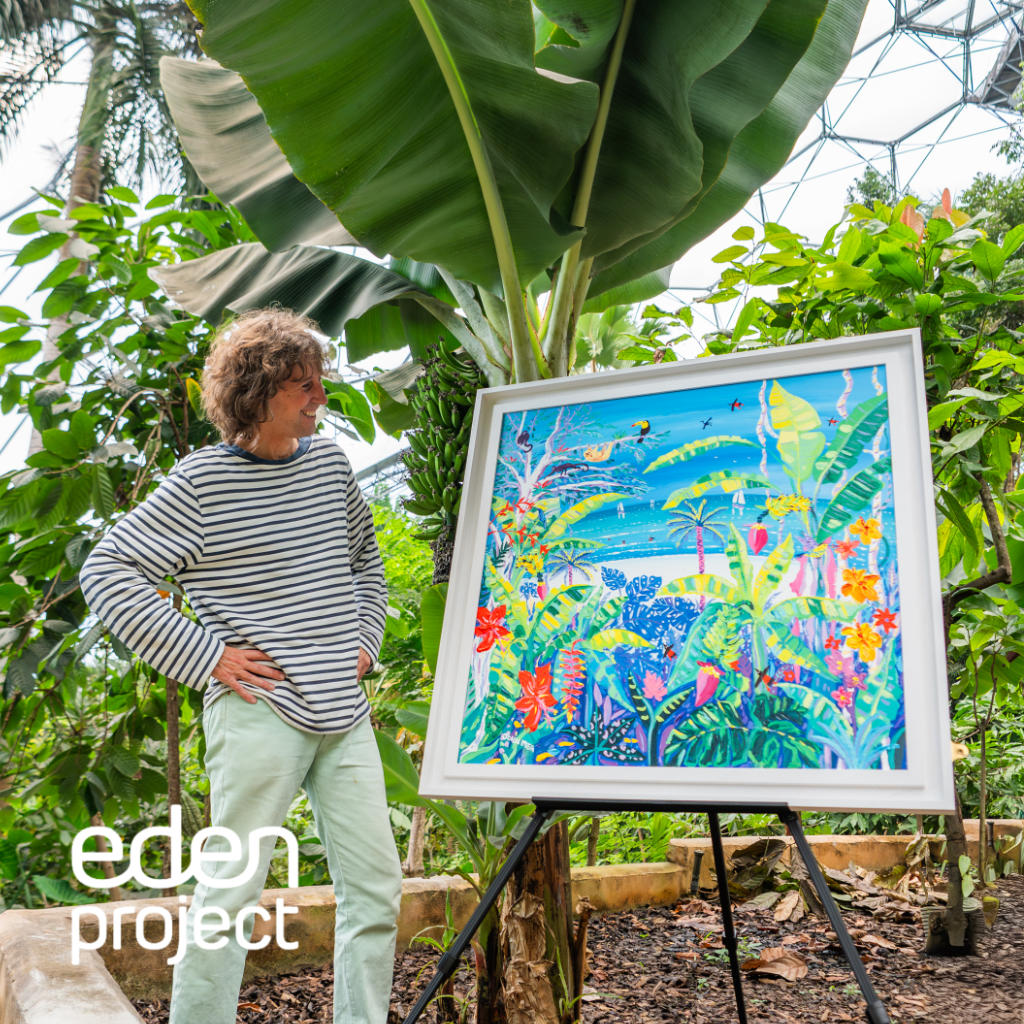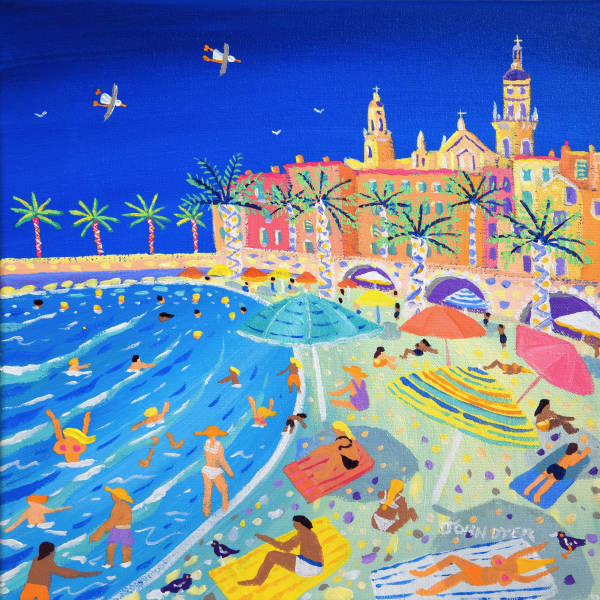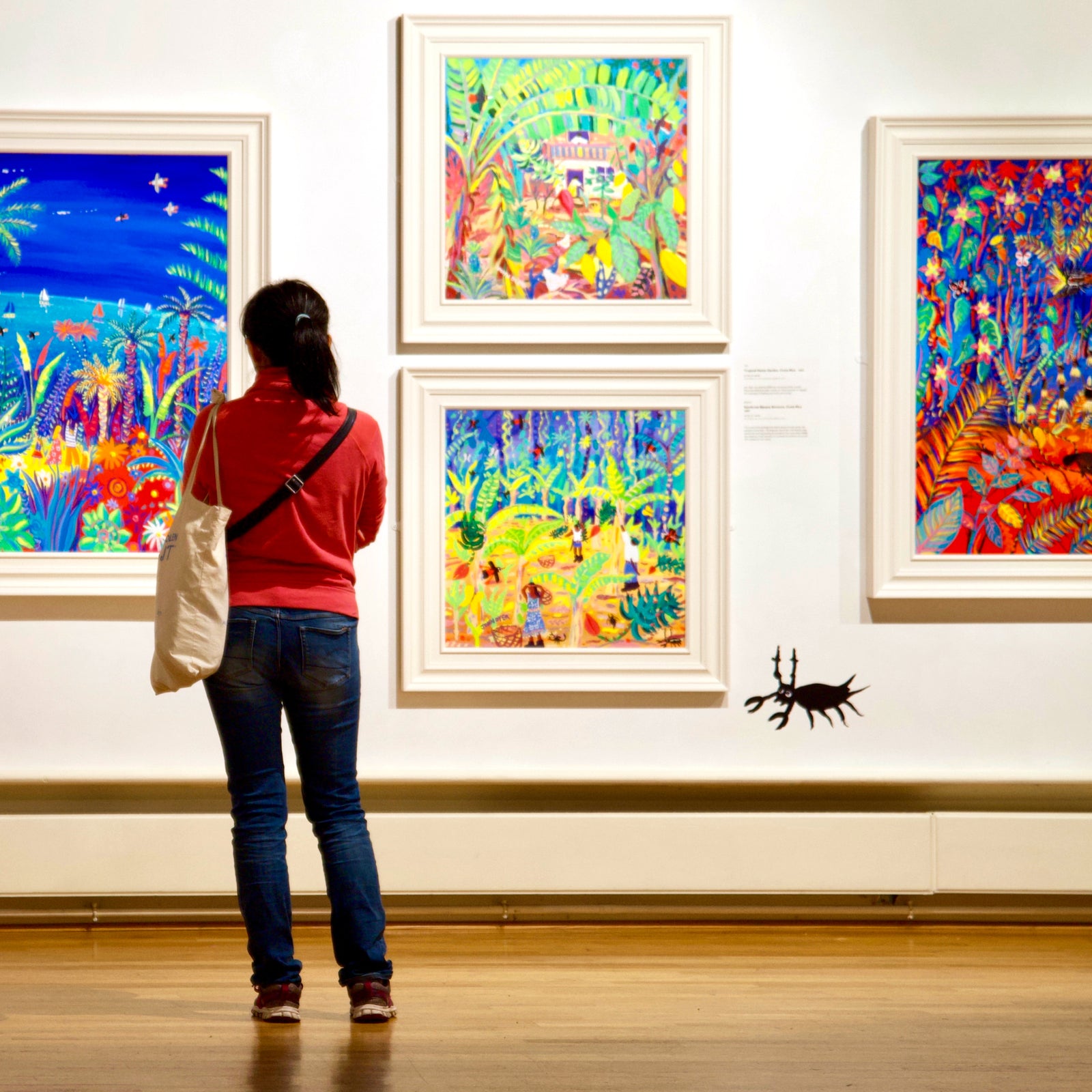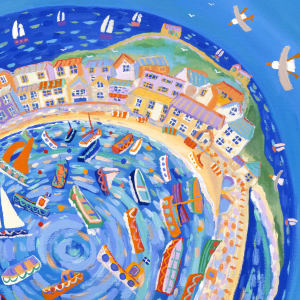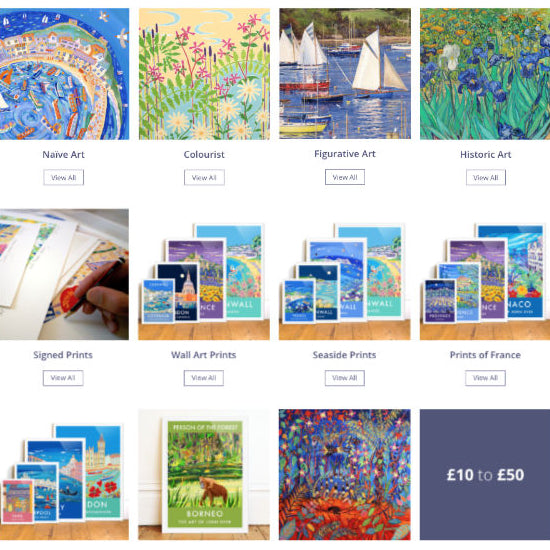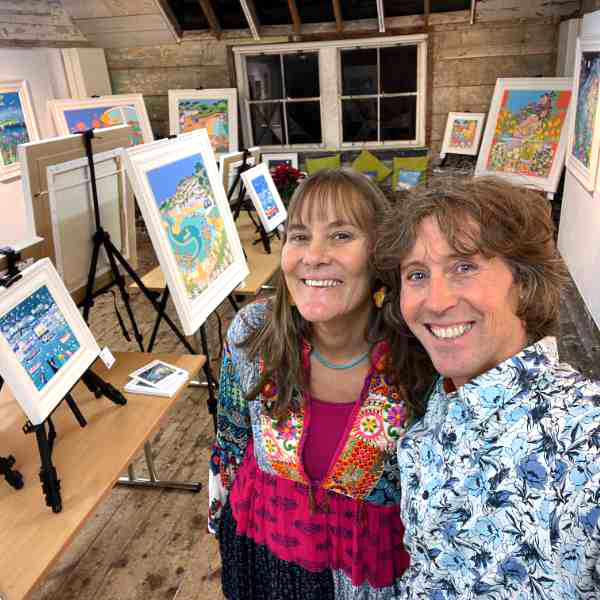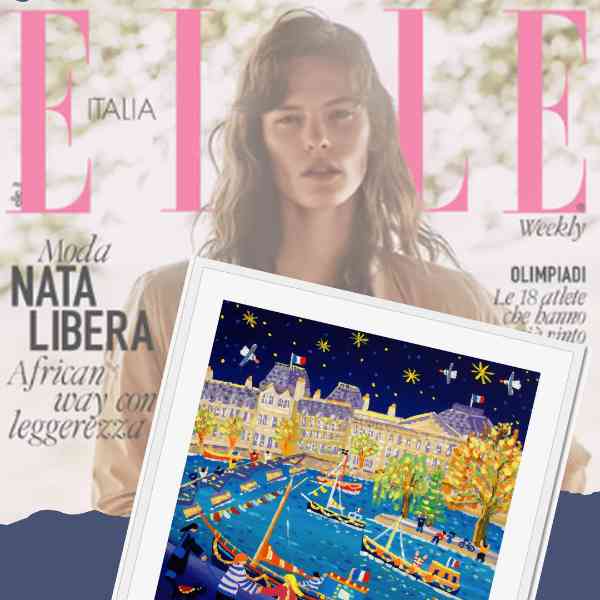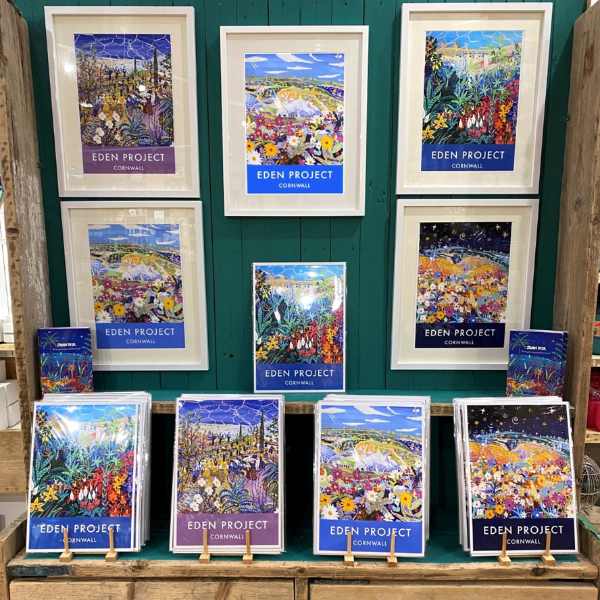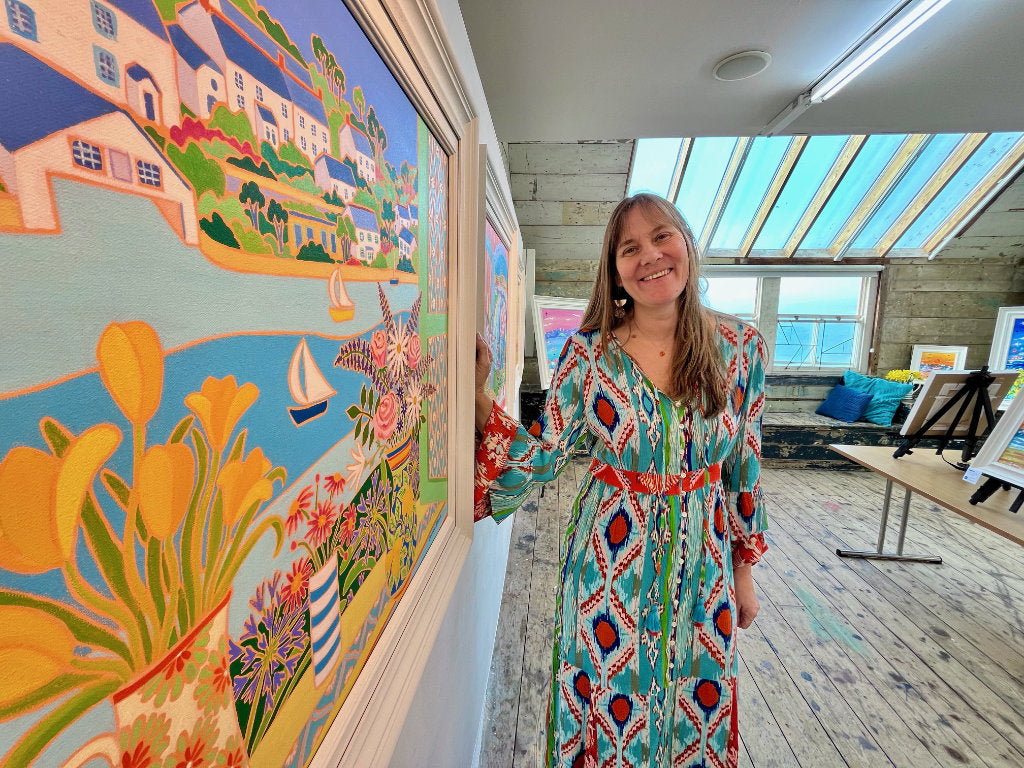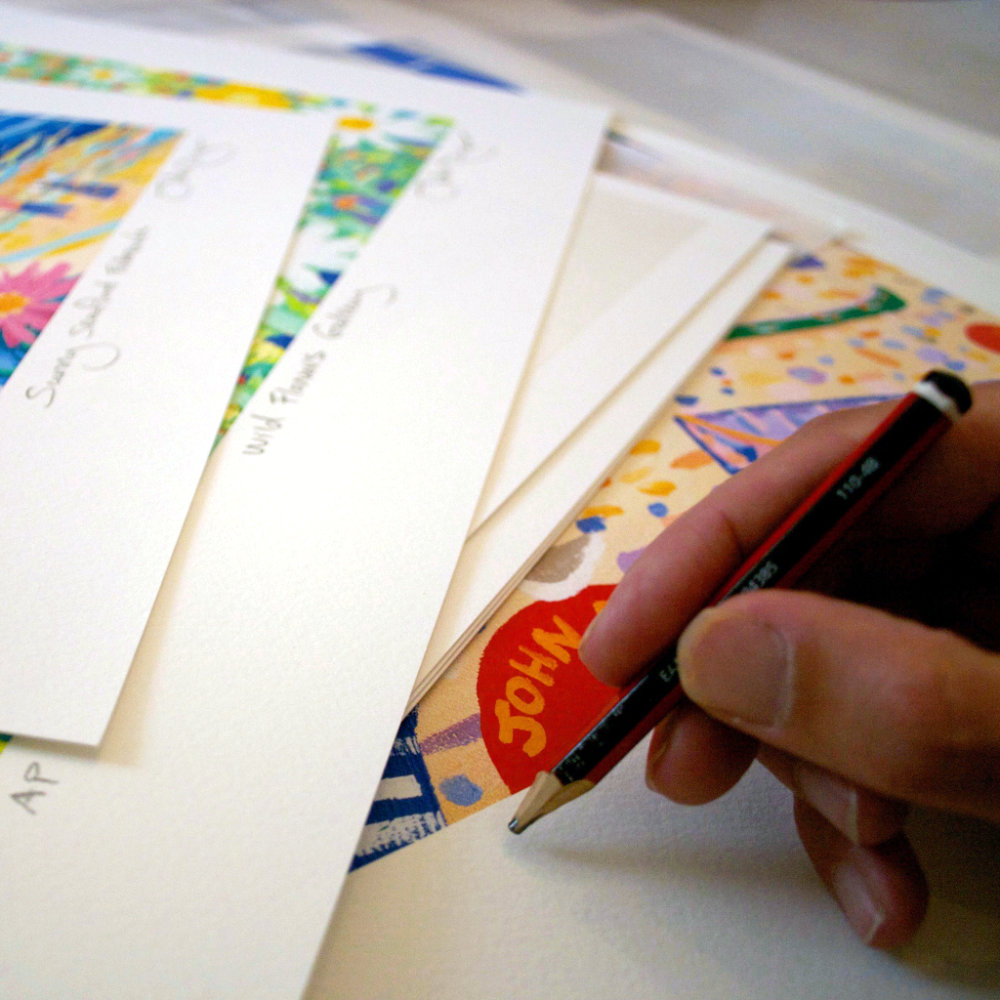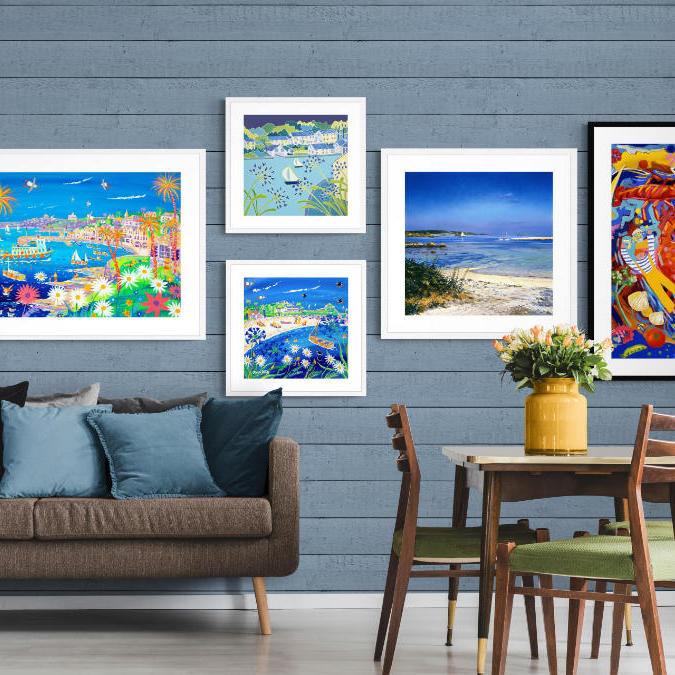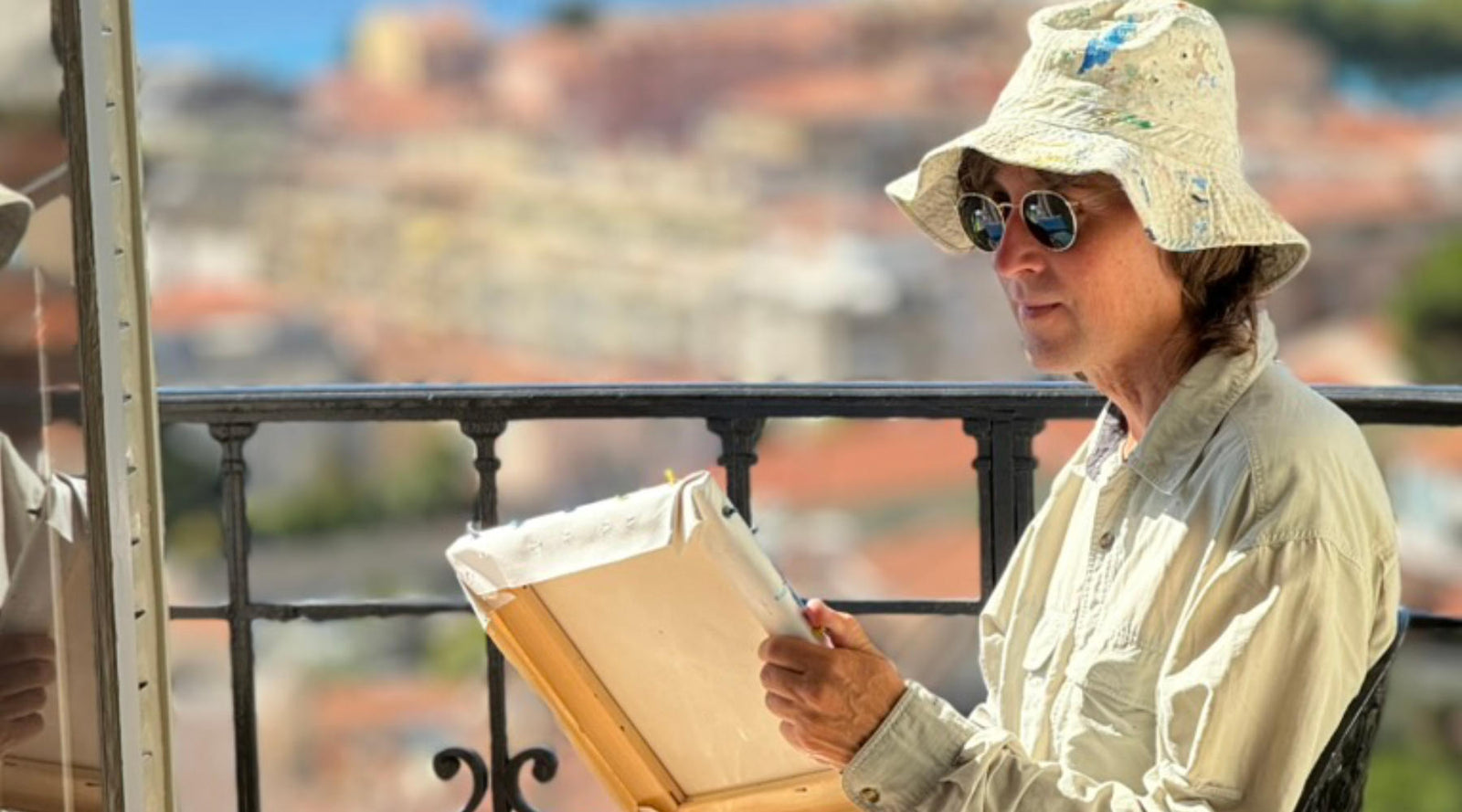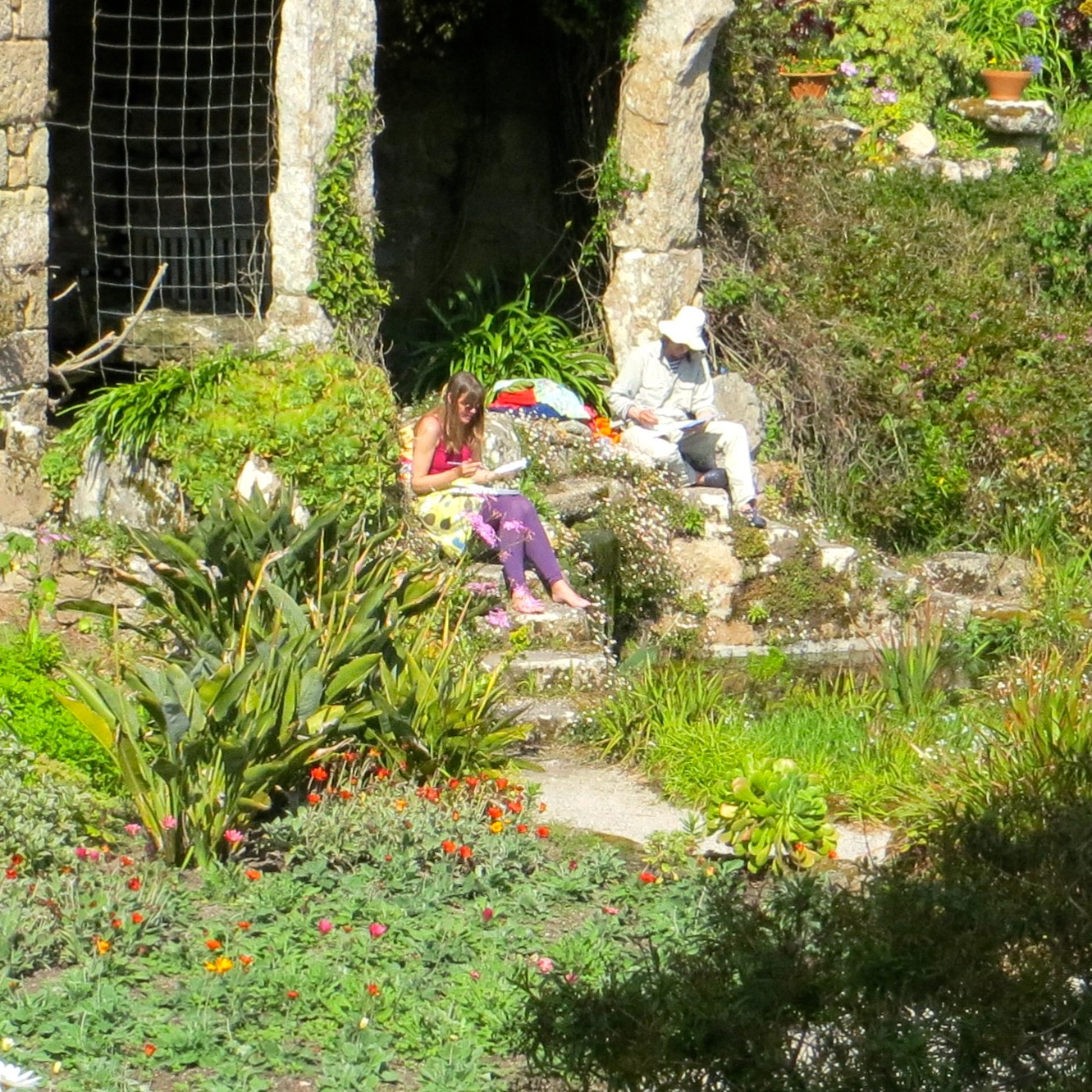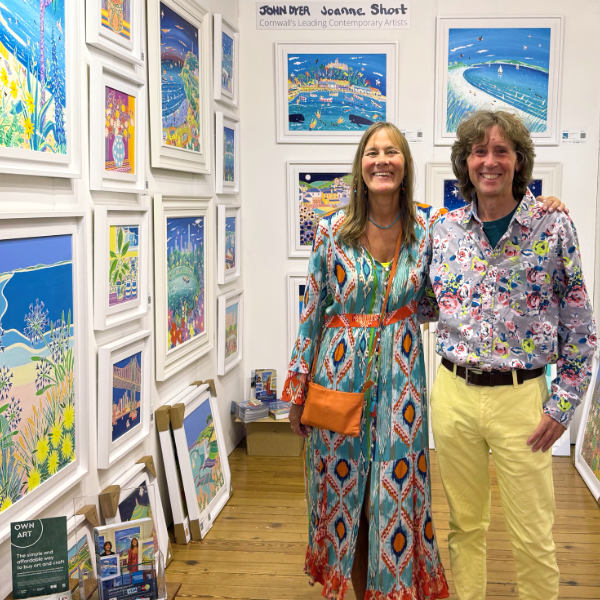
Above: English artist Joanne Short seen at Godrevy Lighthouse in Cornwall with a John Dyer painting
English artists lead the way in the art world, with a wealth of history, culture and creativity to draw upon. From personal stories to social commentary, they tackle a broad range of subjects in many different ways, shaping the global art scene. With roots in English literature, historical events, landscapes, cityscapes and modern-day issues, their work continues to develop, offering new perspectives and challenging the traditional art world. From Tracey Emin and Francis Bacon to the latest talent emerging from Cornwall, such as artists John Dyer and Joanne Short, English artists are a force to be reckoned with.
Buy Art by English Artists Online
Quick Facts
-
What is an English artist? England’s history and culture has a big influence on this definition, especially the mix of literature, visual art and social issues.
-
Tracy Emin, Francis Bacon, and David Hockney are three very different types of English artists. They explore personal experiences and social commentary through different mediums.
-
Cornwall is a big part of the contemporary art scene, with artists like John Dyer, Joanne Short and Ted Dyer and institutions creating an active art community.
Explore English Artists and Their Art
Tracey Emin (b. 1963)

Above: English artist Tracey Emin's 'My Bed' art installation
Tracey Emin is the poster girl of autobiographical art. Her work is a raw, unedited version of her life and traumas. She often uses painting, sculpture, and neon text to explore her life from a feminist perspective.
She is inspired by artists like Edvard Munch and Egon Schiele, whose self-portraiture had a big impact on her style. Her famous installation, ‘My Bed’ at the Tate Gallery, is a great example of how she challenges the traditional idea of art by presenting her unmade bed as a work of art. This piece blurs the line between art and life and forces the viewer to confront the intimacy and vulnerability of personal space.
Emin’s impact goes beyond her controversial pieces. Her work is in major museums around the world, like the Museum of Modern Art in New York and the Tate Gallery. She’s a big player in contemporary art. Through her work, she’s able to make people feel strong emotions and has influenced a generation of artists.
Francis Bacon (1909 - 1992)

Above: Francis Bacon - English Artist. Three Studies for Portrait of Henrietta Moraes
Francis Bacon’s impact on contemporary art is huge. His paintings are raw and emotional and change the way we see the human condition. Born in Dublin but left his mark on the English art scene, Bacon’s work often explores the human body.
Bacon’s approach was new. He combined painting with photography to capture movement and action in his figures of the human body. His upbringing and move to England had a big impact on his artistic view and allowed him to explore spirituality and existential angst.
His emotional paintings, full of intense and often shocking imagery have changed the way we see the human condition. Bacon’s ability to make us feel raw emotion through his work has made him a household name and a major player in contemporary art.
David Hockney (b. 1937)

Above: English artist David Hockney- 'A Bigger Splash' painting
Born in 1937 in Bradford, Hockney is known for his work across many mediums: painting, drawing, printmaking, photography and digital art. He’s a technophile who makes digital art using an iPad and is a quick adopter of new artistic tools.
His 1967 painting, ‘A Bigger Splash,’ is an excellent example of his ability to capture light, space, observation, and perspective. Another notable work, ‘Portrait of an Artist (Pool with Two Figures)’ is a portrait and landscape combined exploring deep emotional themes.
Hockney’s work often explores landscape, portraits, water, and human relationships, creating a rich narrative of images. His work has sold for record prices at auction, making him one of the most valuable living British artists.
Damien Hirst (b. 1965)

Above: Damien Hirst, The Physical Impossibility of Death in the Mind of Someone Living, 1991, Installation, Tiger Shark
Hirst has left his mark on the contemporary art world with his controversial work, which combines art, life, and death. His 1991 piece, ‘The Physical Impossibility of Death in the Mind of Someone Living,’ a preserved tiger shark in formaldehyde, is an icon of contemporary art.
His Spot paintings with their colourful dots are simple to look at but complex in their psychology. He’s made us think and talk about his work, and that’s why he’s one of his generation's most influential British artists.
Hirst’s work has sold well and for big money at auction. He’s made an impact on the art world and can make us think about complex subjects.
Lucian Freud (1922 - 2011)

Above: English artist Lucian Freud's painting - 'Girl with a White Dog' (1951-1952)
Freud’s intensely realistic portraits and nudes have changed modern portraiture. His portraits took many sittings, as he was a perfectionist and wanted to be close to his subjects. His nudes were unflattering, as he rejected traditional beauty in portraiture.
His portrait of Queen Elizabeth II is notable for its intimacy. He shows the Queen’s age and his own unique way of painting. Freud changed his brushstrokes when he switched from sable to hog-hair brushes, allowing him to layer the paint more.
His self-portrait shows us his inner self and his artistic journey; he’s been exploring himself for decades.
Richard Hamilton (1922 - 2011)

Above: Richard Hamilton - 'Just What Is It That Makes Today’s Homes So Different, So Appealing?'
Richard Hamilton is known as the father of Pop Art. His work changed the art world. He challenged the traditional and reflected the rise of consumerism.
One of his most famous works, “Just What Is It That Makes Today’s Homes So Different, So Appealing?”, defines consumerism. Hamilton’s investigation of visual culture has had a lasting effect; he’s made it possible for future artists to critique modern consumerism.
Barbara Hepworth (1903 - 1975)

Barbara Hepworth was one of the few women sculptors of her time to make it internationally in the art world. She started her formal education at Leeds College of Art and then at the Royal College of Art in London, setting her up for life.
She went to Florence to study marble carving with Giovanni Ardini, and in 1939, she moved to St Ives, Cornwall, where she lived for the rest of her life. She moved to bronze in 1956, a significant change in her work.
Barbara Hepworth, along with 19 other artists, was one of the founding members of the Penwith Society of Arts in St Ives in 1949.
Despite personal tragedies, including losing her son in 1953, Hepworth continued to make work influenced by her environment and became known for her lithographs later in her life.
Banksy

Above: English artist Banksy - Girl with Balloon
Despite his fame, Banksy remains anonymous. He communicates through emails and voice alterations. He became a graffiti artist in 1993, starting freehand and then stencils in 2000.
His 2005 work on the West Bank wall shows children playing with a beach view, his unique style and social commentary. Banksy’s work often includes political commentary and social critique; he’s a big name in contemporary art.
John Dyer (b. 1968)

Above: Artist John Dyer painting the last two Northern White Rhino in Kenya
John Dyer is a Cornish artist. He’s the artist in residence at the Eden Project and an Artist for the Earth with EarthDay.org. He is a Fellow of the Royal Geographical Society in London, nominated by Robin Hanbury-Tenison, the society's vice president in 1989. His work is exhibited internationally through prints, posters and exhibitions.
John Dyer's vibrant and colourful paintings capture the essence of the Cornish landscape, flora, and fauna, often featuring scenes from his travels around the world. His distinctive style, characterised by bold colours and dynamic compositions, has made him one of Cornwall's most beloved contemporary artists. Dyer's work not only celebrates the natural beauty of his surroundings but also aims to raise awareness about environmental issues and the importance of conservation.

Above: 'A Day at the Beach, Porthminster Beach, St Ives', 100x100 cm acrylic on canvas. Paintings of Cornwall by English Artist John Dyer.
In addition to his artistic endeavours, John Dyer is deeply committed to educational and community projects. He founded the "Last Chance To Paint" project, which encourages young artists to connect with nature and cultural heritage through art. This initiative has taken him to remote locations around the globe, where he collaborates with local communities and schools to inspire the next generation of artists and environmentalists.
Dyer's contributions to art and education have earned him numerous accolades and recognition. His paintings are held in national collections in the UK, including institutions like Falmouth Art Gallery and the NHS. Through his dynamic and engaging work, John Dyer continues influencing the art world and inspiring audiences worldwide. His dedication to his craft and the environment ensures his legacy will endure for years.
Ted Dyer (b. 1940)

Above: English artist Ted Dyer painting in his studio in Cornwall.
Ted Dyer is a prominent Cornish artist renowned for his impressionist figurative work. Born in 1940 in Bristol, Ted moved to Cornwall, where he found inspiration in the region's stunning landscapes and vibrant light. His paintings often feature the picturesque coastal scenes, harbours, and countryside of Cornwall, rendered with a keen eye for detail and masterful use of colour.
Ted's artistic journey began early, and he honed his skills through self-study and practice. His work is characterised by its warm, inviting palette and the ability to capture the essence of Cornish life. Over the years, Ted has exhibited widely across the UK, and his paintings are held in numerous private and public collections.
Ted Dyer's legacy continues through his son, John Dyer, who is also a celebrated artist. This ensures that the Dyer family's artistic influence will be felt for generations to come.
Joanne Short (b. 1967)

Above: English artist Joanne Short with her colourist paintings exhibited in St Ives, Cornwall
Joanne Short is a celebrated Cornish artist known for her vibrant and colourful paintings of the Cornish landscape. Born in 1967, Joanne has been painting since her early years and has developed a unique style that combines bold colours and simplified forms to capture the essence of the Cornish landscape.

Above: 'Seaside View from Gyllyngdune Gardens, Falmouth', 30x30 inches oil on canvas. Painting by Cornish Artist Joanne Short
She studied at Falmouth School of Art before completing a fine-art degree in Italy. Her work often features Cornwall's picturesque coastal towns, gardens, and countryside, rendered in a unique colourist way that evokes a sense of joy, energy and serenity.
Joanne's art has been widely exhibited in the UK and internationally, and her pieces are held in numerous private and public collections. She is also an elected artist of the Newlyn Society, which recognises her significant contributions to the field of art.
Through her paintings, Joanne Short continues to inspire and captivate audiences, bringing the beauty of Cornwall to life on canvas.
English Art Movements
Several key movements have formed English art, each thread in the fabric. The Pre-Raphaelite Brotherhood in the mid-19th century was a cultural shift, with detailed and colourful representations of literature and religion. Influential art critics like John Ruskin were instrumental in promoting this movement and shaping public taste for English art.
The Royal Society of British Artists (RBA) has played a significant role in fostering artistic talent and maintaining high standards in art exhibitions, celebrating diversity and excellence in the art community.
Romanticism in England was about nature, emotion and individualism, J.M.W. Turner and John Constable painted emotional landscapes, their work still inspires artists today.
The late 20th century saw the YBA (Young British Artists) known for their controversial work and shock tactics to get a reaction from the audience. Emin and Hirst were part of this movement; they took contemporary art to the edge.

Above: Alfred Wallis Framed Open Edition Cornish Art Print. 'The Blue Ship'
Alfred Wallis started the contemporary landscape movement in Cornwall and became famous when Ben Nicholson discovered him in St Ives in the 1950s. St Ives became the centre of the art world at that time. John Dyer and Joanne Short are contemporary Cornish artists who are continuing this movement. The naïve art genre exemplified by Wallis has influenced many Cornish artists and added to the richness of English art.
English Art Galleries

The English art galleries have long been a cornerstone of the art world, offering a platform for both established and emerging artists to showcase their work. These galleries play a crucial role in the cultural landscape, providing a space for artistic expression and appreciation.
The Royal Society of British Artists (RBA) is instrumental in this regard, promoting art and fostering talent through its prestigious exhibitions that celebrate diversity and excellence in the art community.
Above: John Dyer Gallery art exhibition in the Crypt gallery of the St Ives Society of Artists
England has some of the most famous art institutions, which have developed talent and promoted art worldwide. Tate Modern is one of the top modern art destinations in the UK, has over 70,000 works, and is located in a former power station on the River Thames.
The Royal Academy, with its significant exhibitions and the Summer Exhibition open to all, is still at the heart of English art. Emin, who got her MA from the Royal College of Art and is a Royal Academician, is an example of the Academy’s role in developing artistic talent.

Above: English artist Joanne Short at the National Gallery in London enjoying an exhibition of post-impressionist paintings. Pictured - 'Bathers at Asnières' by Georges Seurat
The National Gallery in London is the most famous art gallery in the UK, with a collection of paintings that span centuries. Public access to the big museums in London is free, so everyone can experience culture and develop an appreciation for the arts.
Tate St Ives shows the regional diversity of English art, works that reflect the light and landscape of Cornwall. These institutions keep the heritage of English art alive and inspire the next generation of artists.
Painters from Cornwall in the Art World
Cornwall has a lively and long artistic heritage that is still going strong, so it’s a major player in the art world. Naïve or primitive art is part of Cornwall’s fine art history, started by Alfred Wallis and continued by artists like John Dyer and Joanne Short.

Above: 'Blue sky and Ferry Boats, Greenbank, Falmouth', 30 x 30 inches acrylic on canvas. Coastal Paintings of Cornwall by English Artist John Dyer
John Dyer is Cornwall’s most popular contemporary artist. He is also the artist in residence at the Eden Project and has international recognition for his work. Ted Dyer is Cornwall’s leading impressionist figurative artist, and Joanne Short is an expert in colour, so you can see the diversity and talent of the region.
The development of the transport, especially the railway to Penzance, brought many famous artists to Cornwall and established it as an art colony. Institutions like the Falmouth School of Art (incorporated now into Falmouth University) have been instrumental in shaping the art community in Cornwall.

Above: 'Dinghies on the Beach, Helford Passage', 100x100 cm oil on canvas. Painting by English Artist Joanne Short
The Cornish landscape inspires many artistic styles, including abstract, figurative, and naïve work, especially expressionist work. The internet has allowed Cornish artists to reach a global audience through platforms like johndyergallery.com and show their work to the world, so Cornwall and its artists are a key part of the global contemporary art world.
Conclusion
Contemporary English art is a complex and multifaceted field, with historical influences, cultural change, and individual narratives. From Tracy Emin and Damien Hirst to Joanne Short and John Dyer, these artists are still pushing the boundaries of art.
English art styles, key movements and big institutions show the ongoing conversation between tradition and innovation. Contemporary English artists continue to inspire and shape the art world.
FAQs
Who is the most famous living artist in the UK?
Banksy is the most famous living artist in the UK, known for his street art and social commentary. His work is the embodiment of contemporary art in Britain.
Who were the 20th-century English artists?
20th century modern English artists include David Bomberg, Peter Coker, William Crozier and Terry Frost. They made a big impact on British art during that period.
What is an English artist?
An English artist is a mix of cultural and historical influences from the English Reformation, English literature and classical and modern styles. This complex background informs their art and identity.
Who is Tracy Emin, and what is she known for?
Tracy Emin is a contemporary artist known for her autobiographical and feminist work. She is most famous for her installation ‘My Bed’, which has secured her place in the art world.
What are the main art movements in England?
The main art movements in England are the Pre-Raphaelite Brotherhood, Romanticism, Newlyn artists, St Ives artists and the Young British Artists. Each has played a big part in the development and diversity of English art, and their influence is still seen in contemporary art.
